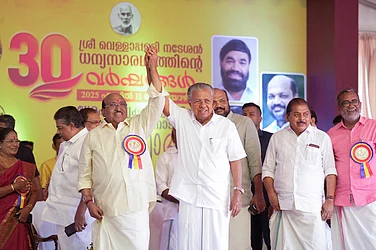It turned out to be a most expensive shopping expedition. During I.K. Gujral's trip to Russia as foreign minister last February, he had got the Russians to agree to sell India two 1,000 MW light water reactors. This was seen as a major diplomatic coup, brought off in the face of strong US objections -- the superpower had cited the 1992 'Supplier's Agreement' which forbids sales of nuclear technology to countries not formally recognised as nuclear states and those that don't allow international inspections of their nuclear facilities.
On hindsight, the 'coup' is proving ill-advised. At RS 7,500-9,000 crone each, the reactors, to be set up at Kudankulam in Tamil Nadu, would be India's most expensive power project. Consider the figures: a thermal plant costs around Rs 3 crore to generate one megawatt; gas-based plants cost about Rs 3.5 crore; a hydel plant only Rs 2.5 crore; but the Kudankulam Nuclear Power Project will cost a whopping Rs 7.5 crore. No state electricity board can afford power at the price this would entail.
The deal to import the VVER reactor was first signed by Rajiv Gandhi in November '88, when Mikhail Gorbachev visited India. The USSR agreed to finance the entire project -- this was in the rupee-rouble days -- to be repaid through a buy-back scheme.
In the new scenario, hard currency payment is required. However, Russia has agreed to extend India credit up to $2,600 million at an interest of 4 per cent per annum. The Atomic Energy Commission (AEC), the Union government and the governments of Tamil Nadu, Kerala, Karnataka and Andhra Pradesh are toying with the idea of joint financing. The main organisations involved are Atom Energy Export (AEE) from the Russian side and India's Nuclear Power Corporation (NPC).
According to a Vienna-based International Atomic Energy Agency (IAEA) official, the sale makes perfect sense to Russia, which is tapping hard currency from all sources. But it makes little sense for India to go in for dollar purchase of a power plan when private companies are vying to set up plants.
Besides, the VVER reactors are not in line with the three-phase orientation of India's nuclear programme: construction of thermal reactors using natural uranium as the first phase, fast breeder reactors using plutonium as the second and thorium breeders as the third.
The safety factor is the most worrying. In September '88, India had signed a pact with the IAEA waiving safeguards for the two VVER 1,000 MW plants --according to this, no external inspection would be insisted upon. This was on the commitment that the entire nuclear spent fuel -- the raw material for weapons grade plutonium -- would be returned to Russia. Which means the highly radioactive spent fuel will be transported by road from Kudankulam to a port, probably Kochi or Tuticorin -- across some densely populated tracts -- and from there by ship to Russia.
The AEC has so far chosen not to reveal either the safety record or the economics of the VVER nuclear plants. The Department of Atomic Energy says safety can be taken for granted as these reactors are light water-cooled and moderated ones with enriched uranium as fuel, unlike the Chernobyl type which uses graphite as moderator and natural uranium derivatives as fuel.
HOWEVER, according to Greenpeace International, 16 out of 48 accidents all over the world, between 1981 and 1985, occurred in VVER plants. A group led by top Austrian scientist Dr Helmut Hirsch has concluded, after checking IAEA documents, that the 28 functioning VVER plants have no extra safety mechanisms.
The 1956 Atomic Energy Act provides for setting up nuclear power plants without any Environmental Impact Assessment Study (EIA); a clearance from the Union environment ministry will do. But the EIAS done on Szewell -- a British nuclear plant, similar in size to Kudankulam -- paints a grim scenario: "If an accident occurs even under normal weather conditions, the radioactive releases will cause damage to public health and property downwind up to 170 km. Residents would have to be forcibly evacuated within six hours up to 16 km, 12 hours up to 25 km, 24 hours up to 75 km and 48 hours up to 140 km. Only after intensive decontamination will people be able to reoccupy their houses. Those within 77 km will be able to come back only after 20 years, within 115 km after five years and within 140 km after a year."
Says environmentalist Shivaji Rao: "In the case of Kudankulam, people in towns like Nagarkovil, Tirunelveli and Palayamkotai in Tamil Nadu and Balaramapuram, Nayyattinkara and Puvar of Kerala fall within 77 km. Tuticorin, Kovilpatti and Tenkasi in TN and Thiruvananthapuram fall within 115 km. The towns of Sattur and Vasudevanallur in Tamil Nadu and Kundara, Killikolur and suburbs of Kollam in Kerala fall within the 140 km belt."
The very installation of the plant will cause mass displacement -- nearly 25,000 people from Kudankulam and neighbouring villages have to be evicted. The livelihood of nearly 2,50,000 fisherfolk is likely to be threatened. Farming activities too will be severely affected in a 10 km area. Of more immediacy is the soft water needed for the reactors: this will have to be drawn from the Pechiparai dam, 30 km from the plant site and the only major irrigation facility in the region.
Moreover, according to a pilot study conducted by St Xavier's College, Palayamkotai, the discharge from the secondary coolant circuit into the sea would devastate the marine ecology.
All this, says Chennai-based NGO Poo Ulagin Nanbargal, is not just about electricity. It's convinced Kudankulam is a hidden route to use spent fuel to produce unclear weapons. A senior SEB official agrees: "Why should a mega-power plant be situated in this southern tip? The transmission loss will be over 40 per cent." The real cost of generating one unit of power will go up to Rs 30. That is, if you don't count the human cost.


























